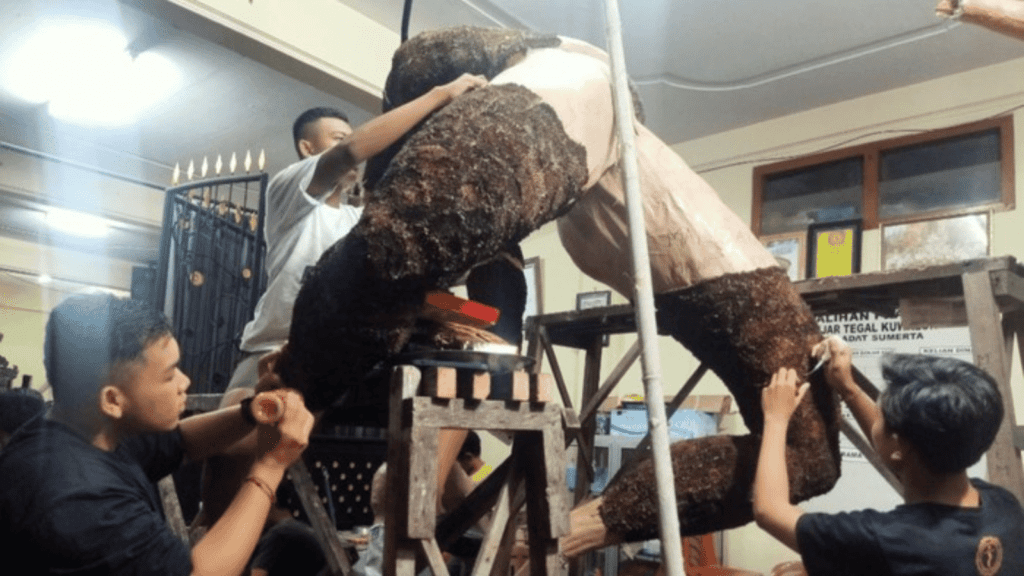In preparation for the Nyepi New Year’s Day ogoh-ogoh competitions, the use of plastic, sponge, and styrofoam materials remains strictly prohibited.
The Tabanan Regency government, through its Department of Culture (Disbud) has banned the use of plastic and styrofoam materials in creating ogoh-ogoh artworks. Additionally, each participant in the competition is provided with financial support from the Tabanan Regency government.
RELEVANT SUSTAINABLE GOALS


I Gede Nyoman Sugiarta, a young expert and member of the ogoh-ogoh judging team, accompanied by Ni Wayan Suciati, Head of the Adat Istiadat Division at Disbud Tabanan, stated that this year’s Nyepi ogoh-ogoh competition will be held specifically in the Adat Kota Tabanan village. The theme for the competition is “Nyomya Butha Kala Nyanggara Nawa Warsa I Caka 1945 Nyujur Jagat Kertih.”
There will be 26 participants in the competition, including 24 traditional banjar communities, one Yowana Adat Kota group, and one tempehan pengabetan group.
What is Ogoh-Ogoh?
According to the website of the Buleleng Regency government, ogoh-ogoh comes from the Balinese word “ogah-ogah,” which means something that is shaken. Ogoh-Ogoh is also a form of sculpture that originates from the culture of the Balinese community and represents the personality of Bhuta Kala.
In Hindu Dharma teachings, Bhuta Kala represents the power (Bhu) of the universe and time (Kala). In the form of ogoh-ogoh, Bhuta Kala is depicted as a large, terrifying, and monstrous figure.
Ogoh-Ogoh is also often portrayed in the likeness of creatures that exist in Mayapada, Syurga, and Naraka, such as dragons, elephants, and celestial beings. Some ogoh-ogoh artworks are even designed to resemble famous individuals, such as world leaders, artists, or religious figures.
Ogoh-Ogoh Using Dried Chili and Other natural ingredients
As is its trademark, STT Tunas Muda Banjar Marta Jati Sidakarya Denpasar Bali always makes ogoh-ogoh made from natural ingredient. For Nyepi 2023, dried chilies, jackfruit leaf bones, dried kaffir lime, coconut petals, and lamtoro fruit skins are used. Work on the ogoh-ogoh, entitled Kali Cita Parlaya, has started since December 2022.
Ogoh-Ogoh From Eggshell and wood shavings
ST Dharma Kusuma from Banjar Sima, Sumerta Kaja Village, East Denpasar showcases the environmentally friendly ogoh-ogoh ‘Lipya Bhisama’, made from bamboo and covered in eggshell and wood shavings, resulting in intricate details. Eggshells were sourced from local sellers, while wood shavings were obtained from carpenters and furniture artisans.
Ogoh-Ogoh Using Jackfruit Skin
STT Adhi Kusuma in Denpasar, Bali, creates eco-friendly ogoh-ogoh using jackfruit skin. This isn’t the first time the school has used natural materials, as they previously used banana leaves in 2018. “We want to continue using environmentally-friendly materials from year to year. We chose jackfruit because of its texture and suitability for ogoh-ogoh,” said the representative.
The raw material for jackfruit skin is obtained from jackfruit traders at the Badung Market. According to Muna, in one day one can get around ten kilograms of jackfruit skin. As for the process of using the jackfruit skin, he continued, the jackfruit skin was steamed, thinned, then cut into small squares. After this stage, continue the roasting process for 10 minutes. The dried jackfruit skin is then attached one by one to the body of the ogoh-ogoh.
You may also be interested in :
Trash Talk : Mandung Tabanan Landfull Severely Overloaded





